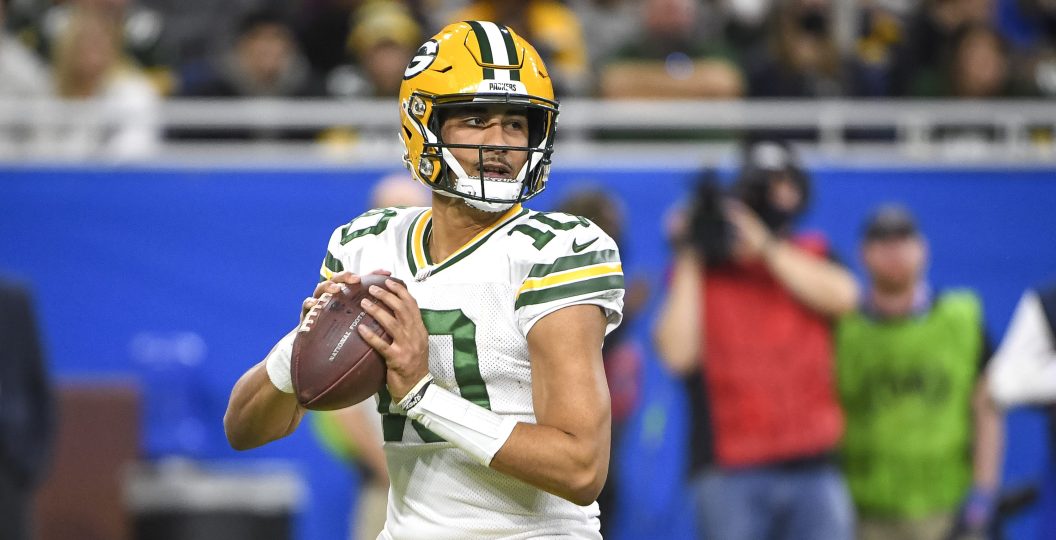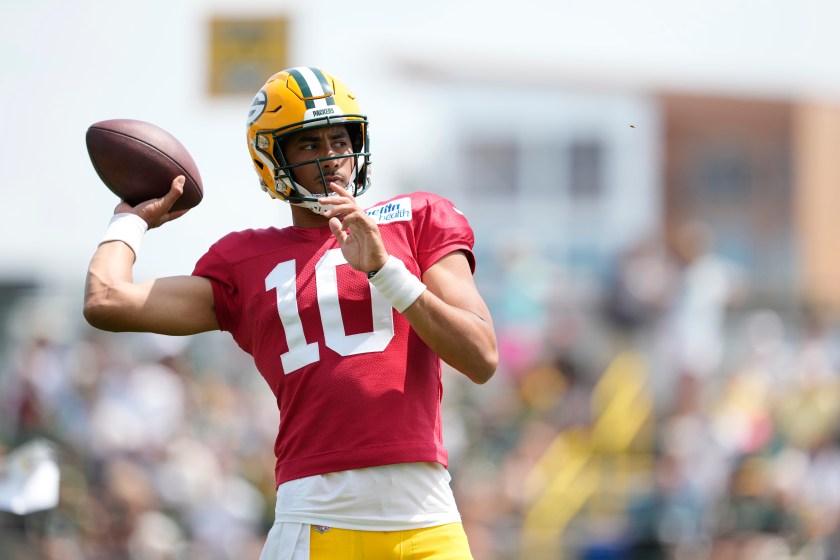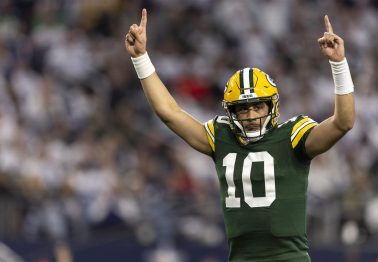The Jordan Love era in Green Bay is finally here.
After sitting for three seasons behind future Hall of Fame quarterback Aaron Rodgers, Love finally gets his turn for the Packers in 2023. In order to get an idea of what we should expect from the newest Green Bay Packers starting quarterback, we must go back and look at his entire NFL career up to this point.
Love only has 157 snaps spread over 10 games, starting just one game back in 2021 against the Kansas City Chiefs. In Week 9, Love stepped in for Rodgers, who was sidelined after testing positive for COVID-19. The Chiefs were 4-4 going into that game, making the Week 9 contest a must-win game against a backup QB.
Arrowhead Stadium was a hostile environment and, in the end, it got the best of Love. The first-round pick lacked poise in the pocket, threw without anticipation, and forced unnecessary throws down the field. He only had a 17% success rate on third down, completing two out of 12 attempts, according to NFL Game Statistics & Information. Love finished the game going 19 for 34 for 190 yards, one touchdown and one interception in a low-scoring, 13-7 loss.
Love only played 26 snaps over four separate games the following season and went 14 for 21 for 195 yards and one touchdown, with a quarterback rating of 112.2. Although he never got an opportunity to start, he showed signs of growth as a player.
Growing pains are normal for an inexperienced quarterback, but the most important thing you want to see on the field is development. Throughout his tenure as a backup, whenever Love went in for an injured Rodgers, it was him taking over a Rodgers-catered offense. That meant a vertical play style with a veteran quarterback having the ability to check out of that particular play depending on the defensive coverage pre-snap. What works for a four-time MVP won't always work for a young quarterback. This is why we saw Love forcing throws and relying on a nonexistent rapport with his receivers against Kansas City. In that Chiefs game, Love had two close picks before his fourth-quarter interception. It seemed as if he was throwing up prayers to anyone who looked open.
Jordan Love Film Study
We can see that lack of comfort in the offense in the two near-picks below. The first throw was a jump ball (and potentially a back-shoulder attempt) up the sideline to Davante Adams on third down, and the other was an off-balance 35-yard throw after a scramble.
According to Sports Info Solutions in 2021, Love had five fade/back-shoulder throws and zero completions. He was still attempting these early in the 2022 preseason game against the Saints on critical downs. In the clip below, it's third and 8, and Juwann Winfree is barely a step ahead of his defender. Instead of leading him, Love expected his receiver to put on the brakes and come back for the ball.
We saw these failed attempts to make plays deep downfield at some of the worst times. When Love saw man coverage with pressure in his face, he relied on his receiver to get open even if they weren't. With pressure came a lack of poise, which prevented proper footwork in the pocket and led to inaccurate throws. We saw it at times during last year's preseason game against the San Fransisco 49ers. In 2022, when he felt pressure, his completion percentage dropped to 33.3%, completing only four passes on 12 attempts, according to Pro Football Focus.
These were the throws that analysts were basing their evaluation on when watching Love over these last three years. He was second-guessing himself, not properly reading leverages and failing to let go of the ball when he hit the back of the pocket. These play calls were never going to help a young quarterback with timing and chemistry. Head coach Matt LaFleur started calling short, high-percentage plays based on timing and using concepts on one side of the field. This was when we started to see growth from preseason into the regular season. This clip below is the second preseason game, against the New Orleans Saints. The two inside receivers clear out the defense, allowing a shallow crosser underneath. Unfortunately, Love doesn't get the ball out.
We see this same play again in Week 12 of the regular season when Love came in for Rodgers in the fourth quarter against the Philadelphia Eagles. This time, the Packers ran a similar concept with trips to the left side. Love recognized the coverage, trusted his eyes and got the ball out quickly.
We saw Love's confidence start to emerge in the only two drives he had against the Eagles. In the clip below, the defense was in a two-high safety look with cornerback Darius Slay and the linebackers in zone coverage underneath. In the first play, the Packers run a "salem" concept to the right side, and Love first looks to his first read and notices Slay in coverage, so he throws the check-down.
On the next drive, the Eagles' defense ran a similar underneath zone coverage with Slay. And instead of the outside receiver getting field to open the underneath, he found space between the cornerback and the safety. Love is able to drop a beautiful ball in the small window up the sideline — but, unfortunately, running back Aaron Jones wasn't able to pull it in.
Two-man concepts like "smash" and "dagger" helped Love achieve one of his best performances of his NFL career. Love went 6 for 9 for 113 yards, one touchdown and a quarterback rating of 146.8 against the Eagles. In the clip below, the Packers call a "smash" concept to the middle of the field targeting linebacker Kyzir White. Depending on whichever receiver he attempts to defend, Love will choose the other.
LaFleur was also running two-man concepts from heavy personnel using play action. This might be the way to go moving forward in order to give Love time and allow him to get out in space to use his legs, if necessary.
In preseason, the Packers ran a "Portland" concept, where one receiver runs a post and the other runs a crosser. This is usually attacking a single-high safety, forcing him to make a choice.
With this being so successful against the Saints, they used this same play against the Eagles.
With Love getting the ball out of his hands so quickly, Christian Watson was able to outrun the defense and put 6 on the board. Unfortunately, this game was already out of reach, but Love showed incredible growth.
Once LaFleur started to understand Love's strengths and stopped relying on his arm, the offense started to come together. According to Sports Info Solutions, in 2022, when the Packers ran play action with Love, his EPA was +4.22; without it, he had an EPA of -16.98. It will be interesting this year to see how this offense looks without Rodgers' influence. Since the calls were tailored to Rodgers' play style and ability to recognize plays, we actually haven't even seen the real LaFleur offense.
For the last few years, fans have seen a vertical play style, but with Love they should see more of a run-heavy offense with play action using schemes to get the ball out of Love's hands quickly on his first or second read.
Despite all of this, Packers fans have to keep realistic expectations for this upcoming season. Four of the six primary pass catchers are rookies, and all six only have two or fewer NFL seasons under their belts. Everyone is young, and fans must have patience early in the season. In the Packers' "Family Night" game, we saw Green Bay's offense struggle early on with his deep throws; then, once Love found his rhythm, we saw some impressive moments. Love will need time to develop, and this isn't something he will just pick up right away. Even Rodgers struggled his first season, going 6-10. The success of the season will fall on LaFleur just as much as it will on Love.


